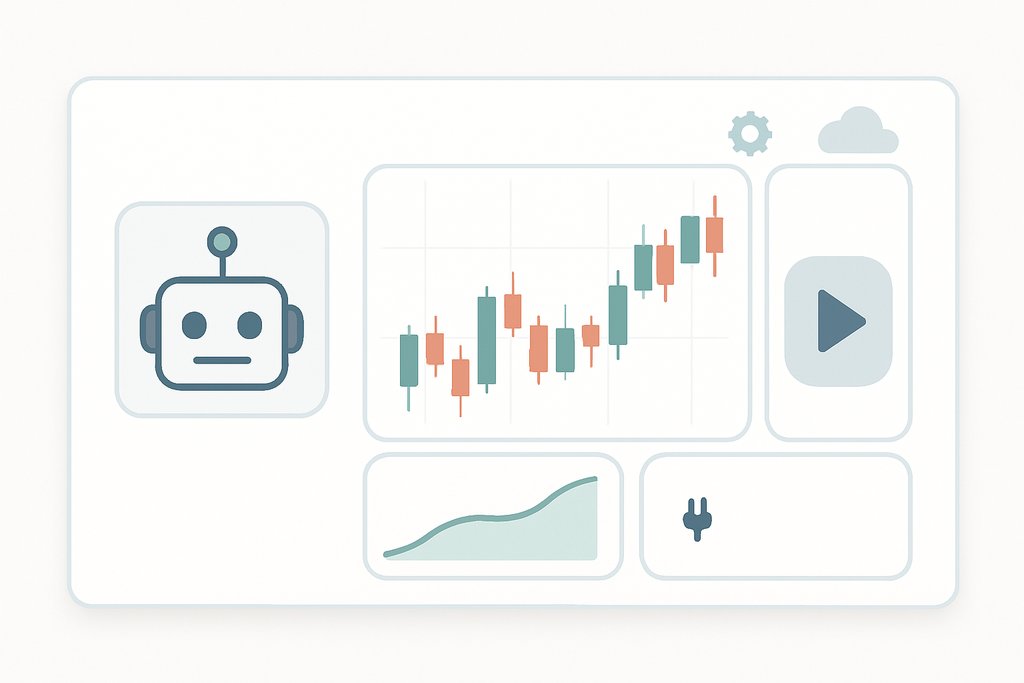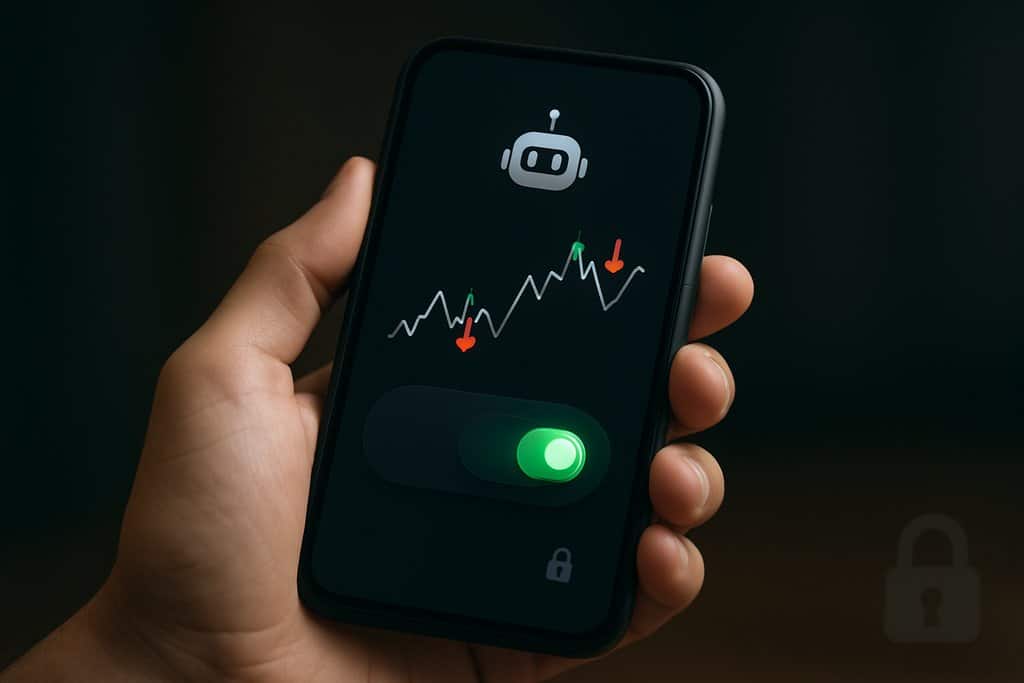Free Trading Bot: Automate Your Trades for $0 Today
Learn how to launch a free trading bot with backtesting, paper trading, and real-time alerts. Compare options, assess risks, and move from idea to execution fast.

Table of contents
- What is a free trading bot and how it works
- Types of free trading bots
- What to evaluate before you trust a bot
- Build your first free trading bot
- Free trading bot strategies to try
- Benefits and key considerations
- Where Obside fits
- Conclusion and next steps
- FAQ
What is a free trading bot and how does it work
A free trading bot is software that monitors markets and executes predefined rules without human intervention, available at no initial cost. It can be open source you run yourself, a platform with a permanent free tier or paper trading, or a freemium service that lets you build and test before paying to go live.
Under the hood, the bot connects to market data and a broker or exchange API, evaluates your conditions, and triggers actions when those conditions are met. A simple example could be an RSI cross strategy on EUR/USD that sends an alert when RSI crosses 70 and MACD turns bearish. A more advanced example could integrate news or macro data, such as selling your stock basket if new tariffs are announced or rebalancing your allocation when volatility spikes.
- Define conditions based on prices or indicators
- Trigger alerts or simulated trades
- Backtest your idea on historical data
- Transition to live trading when ready
For foundations on rules-based systems, see Investopedia’s overview of algorithmic trading. For a deeper dive into the automation stack, explore our guide on automated trading bots.
Types of free trading bots and what they offer
Free trading bots tend to fall into four categories. Each offers a different balance between flexibility, speed, and maintenance.
Open source bots you host yourself
These are programs you run on your own machine or a VPS. You get full control and can customize logic with code. Many rely on exchange APIs and libraries such as CCXT for crypto. The benefits are flexibility and zero software cost. The trade-offs are setup time, maintenance, uptime monitoring, and securing API keys yourself. If you enjoy coding and want absolute control, open source is compelling.
Freemium cloud platforms with a free tier
These services let you build automations online and often include paper trading at no cost, with paid tiers for more alerts, concurrency, or live order routing. The benefit is speed to value and no infrastructure to manage. The free tier may limit frequency, data granularity, or the number of bots you can run.
Free paper trading on pro platforms
Some advanced platforms offer full strategy design and backtesting with paper trading available for free. You only pay when you connect to a broker or move to live trading. This split is great for validating ideas in realistic conditions before committing funds. See our paper trading guide for practical tips.
Signal communities and marketplaces
You can follow strategies published by other traders or import templates. Some strategies are free. You still need a way to execute signals on your exchange or broker. Community content can speed up learning, but always validate with backtests and careful forward tests.
What to evaluate in a free trading bot before you trust it
Choosing a free trading bot is less about price and more about execution quality. A poor execution pipeline can turn a profitable backtest into a losing live strategy. Focus on the following criteria.
Data quality and latency
Your logic is only as good as the data that feeds it. Check if historical data for backtesting and real-time data for live triggers are reliable and time-aligned. Latency matters for intraday strategies. If your conditions rely on a bar close, ensure consistency between backtest bars and live bars to avoid signal drift.
Backtesting accuracy
Look for an engine that respects bar definitions, incorporates fees and slippage, and lets you model position sizing and risk rules. Backtesting is a cornerstone of systematic trading. For key concepts and pitfalls, see Investopedia’s backtesting primer. Also compare how different tools handle walk-forward tests in our trading bot guide.
Broker and exchange connectivity
Your bot is only useful if it can route orders where you trade. Confirm support for your broker or exchange, order types you need, and whether the connection is direct or via a third party. If you plan to scale, verify multiple accounts and portfolio-level rules.
Risk management and safeguards
Ensure stop losses, take profits, and position sizing are available. Advanced users may require trailing stops, ATR-based sizing, and portfolio-level risk controls such as drawdown caps or volatility-based rebalancing. If execution fails, you need alerts and fallback logic.
Customization and triggers beyond price
Sophisticated strategies mix technicals with events. A strong platform supports indicators such as RSI and MACD, but also triggers tied to news, earnings, or macroeconomic data. Event-driven logic expands beyond pure price signals.
Security and API key handling
If you host your own bot, follow strict practices for securing API keys and access. If you use a cloud platform, review their security model and storage approach. Limit API permissions to what your bot needs.
Community, support, and documentation
Free does not have to mean unsupported. Good documentation, active communities, and responsive support can save you hours. If the platform includes a strategy marketplace, quality curation and transparent stats matter.
Build your first free trading bot: two practical paths
You can start in minutes with either a no-code setup or a code-first approach. Pick the path that matches your skills and time.
Path 1: No-code automation with Obside Copilot
Obside turns plain language into executable strategies. Chat with Obside Copilot, describe what you want, and Obside translates that into alerts, orders, and portfolio rules. It handles simple triggers and complex multi-timeframe logic, backed by an ultra-fast backtesting engine.
- Sign up: Create your account at Obside registration. Access the platform at beta.obside.com.
- Describe your bot: Open Copilot and write what you want in plain English. Examples:
- Alert me if Bitcoin rises above 150000 dollars and daily volume doubles
- Notify me if RSI crosses 70 on EURUSD and MACD turns bearish
- Buy 50 dollars of Tesla if Elon Musk tweets about it
- Sell all my positions if the S&P 500 drops by 10 percent
- Backtest in seconds: Check logic on historical data and iterate until clear.
- Paper trade: Validate real-time behavior without risking capital.
- Connect to your broker or exchange: Go live when ready, and manage portfolios.

For indicators referenced above, see RSI and MACD primers on Investopedia.
Path 2: Code-first with open source
If you prefer building your own, a lightweight Python bot is a great start. Keep scope small for the first version and focus on correctness before complexity.
- Define scope: One market, one timeframe, one rule set.
- Choose libraries: For crypto, CCXT helps with exchanges. For backtesting, use a vectorized engine or a simple event loop. Keep secrets out of the repo.
- Build a simple strategy: For example, buy on Supertrend turns and sell on reversal. Add a stop loss and take profit.
- Paper trade: Simulate orders and log entries, exits, PnL, and slippage assumptions.
- Deploy 24/7: Run on a VPS, monitor, and alert on errors or fills.
- Harden risk: Add limits, timeout handling, and fail-safe stops.

Free trading bot strategies to try and why they work
Start with strategies that are easy to reason about and quick to test. Keep rules simple and add risk controls early.
Dollar-cost averaging with smart filters
Buy a fixed amount on a schedule, such as 50 dollars of Bitcoin every Monday at 10:00 AM, and add a filter to avoid extreme overbought conditions. Automation removes timing stress and adds discipline. For crypto specifics, see our AI crypto trading bot primer.
Momentum entries with multi-timeframe confirmation
When the Supertrend becomes bullish on the 2-hour chart, if RSI is not overbought and the Supertrend on the 8-hour chart is also bullish, then buy. Reverse for selling. Add a trailing stop at 5 ATR on the 2-hour chart and close on a flip. This reduces false starts with a higher-timeframe filter.
Mean reversion with risk caps
Look for bullish RSI divergence on a 15-minute chart, buy the signal, set a stop loss at the low of the day, and a 10 percent take profit. Cap risk per trade and per day. Mean reversion can be fragile in strong trends, so risk control is essential.
Event-driven triggers from news or macro data
Sell your stocks if new tariffs are announced, buy oil when a hurricane hits key production areas, or rebalance allocations if volatility spikes. Event-driven logic can diversify beyond pure price signals and is well suited to a platform that integrates news and macro feeds.
Each of these can be prototyped quickly in Obside Copilot or coded in an open source bot. Always backtest across different regimes and forward-test with paper trading before going live.
Benefits of a free trading bot and key considerations
A free trading bot gives you a low-friction way to automate discipline. You can validate logic, remove emotional decision-making, and operate across time zones. With ultra-fast backtests and consistent paper trading, you document your edge with data.
- Validate ideas fast with backtests
- Practice safely via paper trading
- Automate alerts and orders 24/7
- Apply consistent risk rules
There are important considerations to keep in mind:
- Free is not free of risk. Strategy risk, data errors, and execution slippage can erode performance. Model fees and slippage, and expect variance live.
- Overfitting is a threat. Keep parameters few, test across regimes, and favor simple logic that makes market sense.
- Infrastructure matters. If you self-host, implement monitoring, logging, and failover. If you use a platform, review uptime, rate limits, and routing.
- Risk management separates hobby from craft. Define maximum loss per trade, per day, and per portfolio. Use stops and adapt sizing after drawdowns.

Where Obside fits among free trading bot options
If your goal is to explore a free trading bot without getting stuck in configuration, Obside gives you a fast path from idea to execution. Describe your rules in plain language and let Copilot create alerts, orders, and portfolio logic. Backtest in seconds, paper trade to validate real-time behavior, then connect brokers and exchanges when ready.
Obside handles both technical triggers and event-driven conditions such as earnings, macro releases, or specific announcements. It won the Innovation Prize 2024 at the Paris Trading Expo and is supported by Microsoft for Startups. Learn more at obside.com and create your account at beta.obside.com/register.
Conclusion: your next steps to launch a free trading bot
You do not need a big budget to automate your trading. Start with clear logic, backtest it, and run it in paper mode before going live. If you want speed and simplicity, try Obside Copilot to describe your idea in natural language and see it running within minutes. If you prefer full control, build a lean open source bot and validate it thoroughly before deployment.
A simple plan for the week ahead:
- Day 1 to 2: Draft one strategy and two variants. Backtest each.
- Day 3: Paper trade the best variant. Verify signals and logs.
- Day 4: Add risk rules and event-based filters. Backtest again.
- Day 5: Keep paper trading or, if metrics are stable and risks defined, connect your broker and go live with minimal size.
For broader context on tools and selection criteria, compare platforms and approaches in our guide to the best AI trading bots.
FAQ
Are free trading bots profitable?
A free trading bot can be profitable if the underlying strategy has an edge, execution is reliable, and risk is controlled. Profitability comes from the logic and process, not the price of software. Validate with backtesting, then forward-test with paper trading, and scale gradually.
Do I need to code to build a free trading bot?
No. No-code platforms let you describe rules in plain language, backtest, and route orders without writing code. If you want full control or unique custom logic, coding with open source libraries is a strong option. Choose the path that matches your skills and time.
How can I run a free trading bot 24/7?
No-code platforms run in the cloud for you. If you self-host, use a VPS with reliable uptime, configure logging and alerts, and keep your API keys secure. Always implement stop losses and fail-safe checks since servers and networks can experience outages.
What markets are best for a first free trading bot?
Start with a liquid instrument and a timeframe that matches your risk tolerance. Many beginners choose BTCUSD, major forex pairs like EURUSD, or large cap stocks because liquidity reduces slippage and improves fill reliability.
How do I avoid overfitting when backtesting?
Keep rules simple, test across different market regimes, and use out-of-sample data for final validation. Limit parameter tuning, account for fees and slippage, and confirm that live paper trading signals match the backtest logic closely.
